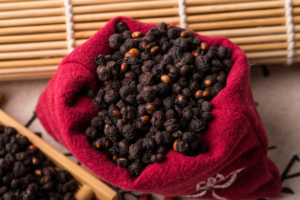Antibacterial Activity
Schisandra chinensis berry extract has showed antibacterial effects against several Gram-positive and Gram-negative bacteria. Schisandra seed oil exhibited a good antibacterial activity against Escherichia coli, Bacillus cereus, Enterobacter aerogenes, Serratia marcescens, and Micrococcus luteus.
Schisandra chinensis extract contans high amounts of terpenes, β-pinene, borneol, and α-pinene, as well as limonene. These compounds display a strong antibacterial activity due to the penetration through the outer membrane of bacterial cells and its severe damage.
Six dibenzocyclooctadiene lignans presented antibacterial activity against pathogenic Chlamydia pneumoniae and Chlamydia trachomatis upon their infection in human epithelial cells. The presence and substitution pattern of methylenedioxy, methoxy, and hydroxyl groups of the lignans had a profound impact on the antichlamydial activity.
 The activity of schisandra chinensis fruit ethanolic and water extracts was tested against typical food-borne pathogens and food-spoiling organisms. Both extracts displayed strong antibacterial activity towards Staphylococcus aureus, Listeria monocytogenes, Bacillus subtilis, B. cereus, Salmonella enterica subsp. enterica serovar Typhimurium, Pseudomonas aeruginosa, Enterobacter aerogenes and E. coli.
The activity of schisandra chinensis fruit ethanolic and water extracts was tested against typical food-borne pathogens and food-spoiling organisms. Both extracts displayed strong antibacterial activity towards Staphylococcus aureus, Listeria monocytogenes, Bacillus subtilis, B. cereus, Salmonella enterica subsp. enterica serovar Typhimurium, Pseudomonas aeruginosa, Enterobacter aerogenes and E. coli.
It was suggested that the main constituents responsible for such activity were organic acids (such as citric and malic acids). Scientists evaluated the minimal inhibitory concentration (MIC) of S. chinensis fruit and leaf extracts for the Gram-positive S. aureus, B. subtilis, and L. monocytogenes, and the Gram-negative bacteria E. coli and S. Typhimurium, which ranged from 10 µg/mL to >100 µg/mL.
These results indicated that Gram-positive bacteria were more sensitive to schisandra chinensis extracts than Gram-negative bacteria. The same was observed for methanol fractions of schisandra chinensis against several Gram-negative (S. Typhimurium, E. coli, Cronobacter sakazakii) and Gram-positive (B. cereus, L. monocytogenes, S. aureus) strains. This difference may result from the difference in cell wall morphology of these microorganisms.
In addition, schisandra chinensis extract was reported to promote growth of Lactobacillus delbrueckii ssp. bulgaricus, while inhibiting activity of Bacillus licheniformis, B. subtilis, and the pathogenic E. coli. The mechanism of inhibition includes changing the permeability of the outer membrane of bacteria, leading to their destruction.
Anti-Cancer Effect
The anti-cancer activity of polyphenols from plant extracts in cancer cell lines includes several mechanisms: Inhibition of tumour proliferation, induction of cell death (apoptotic, autophagic), inhibition of tumour migration and invasion, cell cycle arrest, pro-oxidant activity by stimulation of ROS (reactive oxygen species) production in cancer cell lines, as well as reducing oxidative stress in normal cells and inhibition of carcinogen activity.
and inhibition of carcinogen activity.
Mechanisms of anti-cancer activity of bioactive phytochemicals in Schisandra chinensis. They may inhibit tumour progression through cell cycle arrest at G0/G1 and G2/M, suppression of proliferation, invasion, metastasis, and angiogenesis. schisandra chinensis antioxidative action includes induction of the antioxidant enzymes and direct scavenging of reactive oxygen species (ROS) to prevent cancer induction and progression. Their pro-oxidant effects lead to increased ROS production in cancer cells and cell death (apoptotic and autophagic).
Schisandrin B has been shown to protect against oxidative damage in liver, heart, and brain tissues in rodents. Cell migration and invasion are critically involved in cancer metastasis, the main cause of death in cancer patients. Schisandrin B inhibited the invasion and migration of the human alveolar basal epithelial adenocarcinoma cell line by down-regulating the expressions of hypoxia inducible factor, vascular endothelial growth factor, and matrix metalloproteinases. Then, gomisin A reduced invasion and migration of colorectal cancer cell lines. Recent studies on the mechanisms of anti-cancer action of schisandra chinensis are listed below:
|
Health Effects |
|
Inhibition of triple negative breast cancer growth by inducing cell cycle arrest/apoptosis. |
| Cell cycle arrest at G0/G1, apoptosis, inhibition of invasion, and migration of A549 cells. | |
|
Cytotoxicity in Caco2 cells. |
|
Inhibition of adenocarcinoma cells (ovarian 2008 and colon LoVo) growth by apoptosis correlated with G2/M arrest and tubulin polymerisation. |
|
Apoptosis of renal cell carcinoma Caki-1 by blocking secretion of endothelial growth factor. |
|
Inhibition of human hepatocellular liver carcinoma (HepG2) cells growth via G2/M arrest/apoptosis. |
|
Mitochondria-mediated apoptosis in human renal carcinoma cell line (Caki-1) through the inactivation of the extracellular-signal-regulated kinase (ERK) pathway. |
| Apoptosis of human leukaemia U937 cells by ROS- and caspase-dependent mitochondrial dysfunction and nuclear translocation of mitochondrial pro-apoptotic proteins. | |
|
Suppression of proliferation and cell cycle arrest in G1 in triple-negative breast cancer cells. |
|
Decreased viability of various colorectal cancer cell lines; G0/G1 arrest and apoptosis of CT26 and HT29 cells by regulating cyclin D1/cyclin-dependent kinase 4 (CDK4) expression and apoptotic proteins; reduced invasion and migration of cancer cells. |
|
G0/G1 arrest in human ovarian cancer cells (A2780, SKOV3, and OVCAR3); reduced protumoural phenotype of tumour-associated macrophages (TAMs). |
|
Protection against UVB-induced DNA damage and apoptosis in HaCaT cells via ROS scavenging. |
|
Inhibited proliferation, depolarised mitochondrial membrane and apoptosis by ROS generation and activation of caspase-9 and -3 in AGS human gastric cancer cells. |
|
Cytotoxicity in human leukemic HL-60 cells. |
|
Cytotoxicity in human ovarian (A2780) and endometrial cancer (Ishikawa) cells. |
|
Apoptosis via the Bcl-2 (B-cell lymphoma 2) and MAPK (mitogen activated protein kinase) signalling pathways. |
|
Inhibition of migration and colony formation of tumour cells, prevention of growth of TNBC cells in mice via suppression of signal transducer and activator of transcription-3 (STAT3) phosphorylation and nuclear translocation. |
|
Antitumor and antiangiogenic activity associated with the up-regulation of Bax and p53, downregulation of Bcl-2, as well as the reduction of CD31 and CD34 in tumours in BALB/c nude mice. |
|
Inhibition of metastasis of colorectal cancer in a lung metastasis mouse model. |
|
Apoptosis in human osteosarcoma cells (1547). |

Leave A Comment